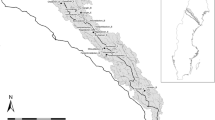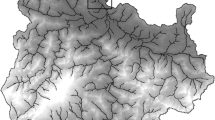Abstract
Stream channels are usually more stable in forested watersheds. However, intensive land disturbances in forested watersheds may disrupt the balance between flow and sediment supply, and result in variations in stream morphology even in the presence of well-designed best management practices (BMPs). This study evaluated the impacts of upstream land disturbances on downstream stream morphology where streamside management zones (SMZs) were present in two small adjacent watersheds in Auburn, Alabama, USA. Field surveys including the measurements of channel cross sections at bankfull stage were conducted at 12 survey sites over an 18-month period. Both in-stream sediment deposition and erosion were observed downstream of the disturbed areas in the study watersheds. As a result, channel cross sections exhibited very dynamic patterns changing frequently over short time periods. Overall, the dominant process was in-stream deposition in both watersheds due to large amount of sediment delivered from upstream-disturbed areas. In spite of the dynamic patterns of the channel cross sections in response to upstream disturbances, the commonly used parameters of Rosgen stream classification remained stable, suggesting that the upstream disturbances did not lead to changes in stream classification. In general, bank erosion was not observed. Therefore, it is likely that SMZs in each watershed were sufficient to stabilize streambanks by hindering in-stream bank erosion. Moreover, the poorly designed BMPs such as silt fences and straw bales near the disturbed area seemed insufficient to balance the variations in sediment supply under the impacts of upstream disturbances. This study emphasized that proper installation and continuous monitoring of BMPs should play a critical role on watershed management. It also indicated that watershed management should be handled using a holistic approach with well-distributed BMP applications within the entire watershed.






Similar content being viewed by others
References
Alabama Cooperative Extension System (2009) Management planning for the Mary Olive Thomas Demonstration Forest 2010–2015. Auburn University School of Forestry and Wildlife Sciences, Auburn
Alabama Forestry Commission (2007) Alabama’s best management practices for forestry publication. http://www.forestry.alabama.gov/Publications/BMPs/2007BMPManual.pdf. Accessed 12 Mar 2017
Allmendinger NE, Pizzuto JE, Moglen GE, Lewicki M (2007) A sediment budget for an urbanizing watershed, 1951–1996, Montgomery County, Maryland, USA. J Am Water Resour Assoc 43(6):1483–1498
AWWB (2011) Source water protection area delineation report for Auburn Alabama. Spectrum Project Number 2476-001. Water Works Board of the City of Auburn, AL, p 37
Bilby RE, Sullivan K, Duncan SH (1989) The generation and fate of road-surface sediment in forested watersheds in southwestern Washington. For Sci 35(2):453–468
Boix-Fayos C, Barberá G, López-Bermúdez F, Castillo V (2007) Effects of check dams, reforestation and land-use changes on river channel morphology: case study of the Rogativa catchment (Murcia, Spain). Geomorphology 91(1–2):103–123
Brantley EF, Helms B, Jennings GD, Anderson CJ, Shaw JN, Zink J, Price Z (2013) Eco-morphological stream design and assessment tools for the Alabama Piedmont (p 111, Final Rep). US environmental protection agency region 4 wetland program development grant
Cavus I, Kalin L, Kara F (2017) Impacts of urban headwater disturbances on downstream sediment loading where streamside management zones for forest harvesting activities are present downstream. Int J Sediment Res 32(4):555–563
Chang M (2006) Forest hydrology: an introduction to water and forests, 2nd edn. CRC Press Taylor and Francis Group, Boca Raton
Corbett CW, Wahl M, Porter DE, Edwards D, Moise C (1997) Nonpoint source runoff modeling A comparison of a forested watershed and an urban watershed on the South Carolina coast. J Exp Mar Biol Ecol 213(1):133–149
Cristan R, Aust WM, Bolding MC, Barrett SM, Munsell JF, Schilling E (2016) Effectiveness of forestry best management practices in the United States: literature review. For Ecol Manag 360:133–151
Doll BA, Wise-Frederick DE, Buckner CM, Wilkerson SD, Harman WA, Smith RE, Spooner J (2002) Hydraulic geometry relationships for urban streams throughout the Piedmont of North Carolina. J Am Water Resour Assoc 38(3):641–651
Doten CO, Bowling LC, Lanini JS, Maurer EP, Lettenmaier DP (2006) A spatially distributed model for the dynamic prediction of sediment erosion and transport in mountainous forested watersheds. Water Resour Res 42(4):W04417. https://doi.org/10.1029/2004WR003829
Elmore AJ, Kaushal SS (2008) Disappearing headwaters: patterns of stream burial due to urbanization. Front Ecol Environ 6(6):308–312
Fifeld JS (1999) When best management practices become “bad management practices. In: Proceedings of International Erosion Control Association Conference, 17 Feb 1998, Nashville, pp 189–203
Franzluebbers AJ, Wright SF, Stuedemann JA (2000) Soil aggregation and glomalin under pastures in the southern Piedmont USA. Soil Sci Soc Am J 64(3):1018–1026
Galster JC, Pazzaglia FJ, Germanoski D (2008) Measuring the impact of urbanization on channel widths using historic aerial photographs and modern surveys 1. JAWRA J Am Water Resour Assoc 44(4):948–960
Goldman SJ, Jackson K, Bursztynsky TA (1986) Erosion and sediment control handbook. McGraw-Hill, New York
Grace JMIII (2005) Forest operations and water quality in the south. Trans ASAE 48(2):871–880
Hall CJ, Jordaan A, Frisk MG (2011) The historic influence of dams on diadromous fish habitat with a focus on river herring and hydrologic longitudinal connectivity. Landsc Ecol 26(1):95–107
Hardison EC, O’Driscoll MA, Deloatch JP, Howard RJ, Brinson MM (2009) Urban land use, channel incision, and water table decline along Coastal Plain Streams, North Carolina. JAWRA Journal of the American Water Resources Association 45(4):1032–1046
Harrelson CC, Rawlins CL, Patyondy JP (1994) Stream channel reference sites: an illustrated guide to field technique (Tech. Rep. No. RM-245). US Department of Agriculture, Forest Service, Rocky Mountain Forest and Range Experiment Station, Fort Collins. https://doi.org/10.2737/RM-GTR-245
Hassan MA, Church M, Lisle TE, Brardinoni F, Benda L, Grant GE (2005) Sediment transport and channel morphology of small, forested streams 1. JAWRA J Am Water Resour Assoc 41(4):853–876
Hey RD (1997) Stable river morphology. In: Throne CR, Hey RD, Newsom MD (eds) Applied fluvial geomorphology for river engineering and management. John Wiley, Chichester, pp 223–268
Hutchens JJ, Batzer DP, Reese E (2004) Bioassessment of silvicultural impacts in streams and wetlands of the Eastern United States. Water Air Soil Pollut Focus 4(1):37–53
Kara F, Kalin L, Loewenstein EF (2014) Sediment dynamics following active management of a stream buffer zone: a case study. J Soil Water Conserv 69(2):87–94
Keen-Zebert A (2007) Channel responses to urbanization: scull and mud creeks in Fayetteville, Arkansas. Phys Geogr 28(3):249–260
Knox JC (1977) Human impacts on Wisconsin stream channels. Ann Assoc Am Geogr 67(3):323–342
Lakel W (2008) Effects of forestry streamside management zones on stream water quality, channel geometry, soil erosion, and timber management in the Virginia Piedmont. Doctoral dissertation, Virginia Tech
Lee JG, Selvakumar A, Alvi K, Riverson J, Zhen JX, Shoemaker L, Lai FH (2012) A watershed-scale design optimization model for stormwater best management practices. Environ Model Softw 37:6–18
Leopold LB, Huppman LR, Miller A (2005) Geomorphic effects of urbanization in forty-one years of observation. Proc Am Philos Soc 149:349–371. https://doi.org/10.2307/4598940
Liébault F, Gomez B, Page M, Marden M, Peacock D, Richard D, Trotter CM (2005) Land-use change, sediment production and channel response in upland regions. River Res Appl 21(7):739–756
Liu Y, Engel BA, Flanagan DC, Gitau MW, McMillan SK, Chaubey I (2017) A review on effectiveness of best management practices in improving hydrology and water quality: needs and opportunities. Sci Total Environ 601:580–593
MacKenzie MD (1999) Private forest landowners and GIS: an exercise in technology transfer. http://www.esri.com/library/userconf/proc99/proceed/papers/pap613/p613.html. Accessed 15 June 2017
Markewitz DD (2007) Understanding soil change: soil sustainability over millennia, centuries, and decades. Cambridge University Press, Cambridge
McNutt RB, Tuck M, Hoyum RA (1981) Soil survey of Lee County, AL. United States Department of Agriculture and Soil Conservation Service. http://soildatamart.nrcs.usda.gov/Manuscripts-/AL081/0/Lee.pdf. Accessed 12 Aug 2017
Moore R, Spittlehouse DL, Story A (2005) Riparian microclimate and stream temperature response to forest harvesting: a review. J Am Water Resour Assoc 41(4):813–834
Naiman RJ, Decamps H (1997) The ecology of interfaces: riparian zones. Annu Rev Ecol Syst 28:621–658
Nakamura F, Swanson FJ (1993) Effects of coarse woody debris on morphology and sediment storage of a mountain stream system in western Oregon. Earth Surf Proc Land 18(1):43–61
Napton DE, Auch RF, Headley R, Taylor JL (2010) Land changes and their driving forces in the southeastern United States. Reg Environ Change 10(1):37–53
Neilson M (2016) Piedmont upland physiographic section. http://www.encyclopediaofalabama.org/article/h-1309. Accessed 28 May 2019
Nelson EJ, Booth DB (2002) Sediment sources in an urbanizing, mixed land-use watershed. J Hydrol 264(1–4):51–68
Nelson PA, Smith JA, Miller AJ (2006) Evolution of channel morphology and hydrologic response in an urbanizing drainage basin. Earth Surf Proc Land 31(9):1063–1079
Palmer JA, Schilling KE, Isenhart TM, Schultz RC, Tomer MD (2014) Streambank erosion rates and loads within a single watershed: bridging the gap between temporal and spatial scales. Geomorphology 209:66–78
Price K, Leigh DS (2006) Morphological and sedimentological responses of streams to human impact in the southern Blue Ridge Mountains, USA. Geomorphology 78(1–2):142–160
Ralph SC, Poole GC, Conquest LL, Naiman RJ (1994) Stream channel morphology and woody debris in logged and unlogged basins of western Washington. Can J Fish Aquat Sci 51(1):37–51
Raymond DE, Osborne WE, Copeland CW, Neathery TL (1988) Alabama stratigraphy: geological survey of Alabama circular 140. Alabama Geological Survey, Tuscaloosa, p 97
Rice EW, Baird RB, Eaton AD (2017) Standard methods for the examination of water and wastewater, 23rd edn. American Public Health Association, Washington, DC
Rosgen DL (1994) A classification of natural rivers. Catena 22(3):169–199
Rosgen DL (2001) A stream channel stability assessment methodology. In: Proceedings of the Seventh Federal Interagency Sedimentation Conference, Reno, vol 2, pp 18–26
Sapkale JB (2014) Channel disturbance and variations in channel cross-sections of Tarali River, Maharashtra: using advanced surveying techniques and transit theodolite. Int J Emerg Technol Adv Eng 4(5):455–462
Schoonover J (2005) Hydrology, water quality, and channel morphology across an urban-rural land use gradient in the Georgia Piedmont, USA. Doctoral Dissertation, Auburn University, 16 Dec 2005
Schumm SA (2003) The fluvial system. Blackburn Press, Caldwell
Simpson H (2002) Texas A&M Forest service: water resources. http://tfswater.blogspot.com/2002/06/june-bmp-q.html. Accessed 8 Oct 2017
Sponseller RA, Benfield EF, Valett HM (2001) Relationships between land use, spatial scale and stream macroinvertebrate communities. Freshw Biol 46(10):1409–1424
Srinivasan R (2005) ArcSWAT: ArcGIS interface for soil and water assessment tool (SWAT). Texas A&M University, Temple
Trimble SW (1997) Contribution of stream channel erosion to sediment yield from an urbanizing watershed. Science 278:1442–1444
US Department of Agriculture (2015) 2015 National Resources Inventory (Summary Rep.). Washington: Natural Resources Conservation Service, and Ames: Center for Survey Statistics and Methodology
US Geological Survey (USGS) (2014) Load estimator (LOADEST): a program for estimating constituent loads in streams and rivers. http://water.usgs.gov/software/loadest/. Accessed 25 Sept 2014
Vowell JL (2001) Using stream bioassessment to monitor best management practice effectiveness. For Ecol Manag 143(1–3):237–244
Ward JM, Jackson CR (2004) Sediment trapping within forestry streamside management zones: Georgia Piedmont, USA. J Am Water Resour Assoc 40(6):1421–1431
Willett CD, Lerch RN, Schultz RC, Berges SA, Peacher RD, Isenhart TM (2012) Streambank erosion in two watersheds of the central claypan region of Missouri, United States. J Soil Water Conserv 67(4):249–263
Wishovski JM, Mano M, Bubenzer GD (1998) Trap efficiencies of filter fabric fence (ASAE Tech. Rep. No. 982158). American Society of Agricultural Engineers, St. Joseph
Wolman MG (1954) A method of sampling coarse river-bed material. Trans Am Geophys Union 35(6):951–956
Acknowledgements
The authors acknowledge the Turkish Ministry of National Education for provision of a full scholarship to the first author during this research. Additional financial support was provided by the Auburn University Center for Environmental Studies at the Urban Rural Interface and the USDA McIntire-Stennis Cooperative Forestry Program.
Author information
Authors and Affiliations
Corresponding author
Additional information
Publisher's Note
Springer Nature remains neutral with regard to jurisdictional claims in published maps and institutional affiliations.
Rights and permissions
About this article
Cite this article
Cavus, I., Kalin, L. & Kara, F. Changes in stream morphology protected by best management practices under effects of upstream disturbances. Environ Earth Sci 78, 526 (2019). https://doi.org/10.1007/s12665-019-8540-5
Received:
Accepted:
Published:
DOI: https://doi.org/10.1007/s12665-019-8540-5




